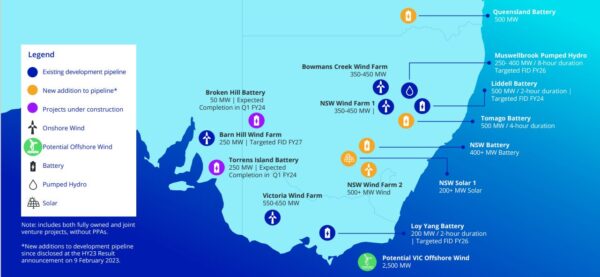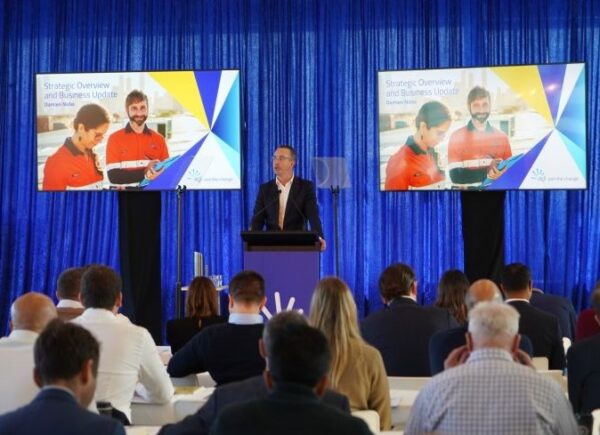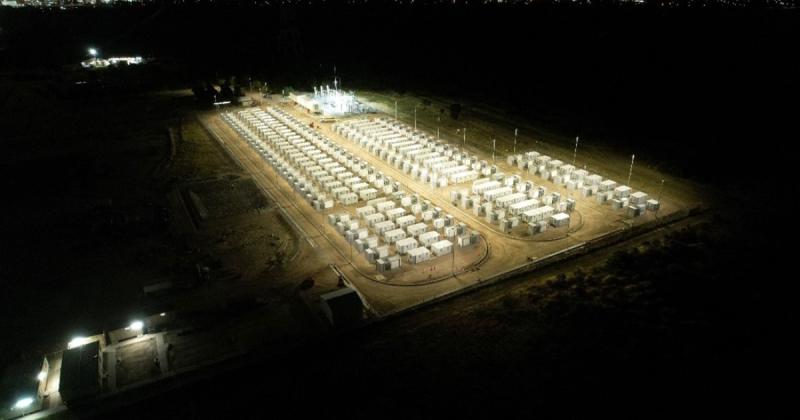Energy utility AGL has revealed it plans to build a 500 MW battery with four hours of dispatchable capacity next to the Tomago aluminium smelter near Newcastle on the New South Wales (NSW) Central Coast as part of its ambition to add 12 GW of new wind, solar and energy storage to its portfolio by 2035. This includes an interim target to have up to 5 GW of new renewables and firming in place by the end of the decade.
AGL told an investor briefing in Melbourne on Friday the 500 MW/2,000 MWh battery to be built alongside the Tomago smelter, which is the biggest consumer of electricity in NSW, accounting for more than 10% of electricity use in the state, is part of a renewables development pipeline that has swelled from 3.2 GW to 5.3 GW in the past four months.
AGL also revealed an unidentified 400 MW battery project in NSW and a 500 MW project in Queensland have formally entered its growing pipeline of renewable generation and storage developments. The power giant also revealed plans for a 200 MW solar farm to be developed in NSW.
AGL Chief Executive Officer and Managing Director Damien Nicks said the addition of the new projects means the company is “well positioned” to achieve its decarbonisation strategy which requires it to increase its development portfolio of renewable energy generation from 1.7 GW to 8 GW of wind and solar by 2035. It will also seek to grow its firming capacity, including grid-scale batteries and pumped hydro, from 1.4 GW to 7.3 GW over that period.

Image: AGL
The company has previously announced plans to exit coal-fired generation by 2035 and on Friday reaffirmed its commitment to close down its Bayswater power station in the Hunter Valley between 2030 and 2033 while the Loy Yang A power plant in Victoria’s Latrobe Valley will be shuttered in 2035.
“This is the biggest transition that this market has ever seen in terms of what we are doing over the next 12 years,” Nicks said. “Today we are sharing with the market how we will deliver on our strategy to connect our customers to a sustainable future and transition our energy portfolio.”
“I’m very pleased to say we have positive momentum in terms of operational performance, continued customer growth and progress against the delivery of our strategy, including advancing our development pipeline with the Torrens Island and Broken Hill batteries, which will be operational later this year.”
AGL is in the final stages of bringing the 250 MW/250 MWh battery at South Australia’s Torrens Island online with the 50 MW/50 MWh battery being developed near the outback NSW city of Broken Hill expected to switch on in the next three months.
Investors were told AGL is on target to deliver 850 MW of grid-scale batteries by the end of 2025 with the utility planning to fact track the development of a 500 MW/2 GWh big battery at the site of the now-shuttered Liddell coal-fired power plant in the Hunter Valley.

Image: AGL
AGL said the final investment decision on the Liddell battery has been brought forward to the end of this year, with the first 250 MW stage expected to receive funding from the Australian Renewable Energy Agency (ARENA).
AGL said it expected to fund 5.5 GW of its targeted 12 GW of new firmed renewables capacity from its own balance sheet, while the other 6.5 GW would be procured via joint ventures, partnerships, third-party offtakes and distributed energy resources including rooftop solar.
The company expects to outlay between $8 billion (USD 5.5 billion) to $10 billion to deliver the 5.5 GW with the majority of that spend to occur in the first half of next decade.
Also on Friday AGL announced upgraded full-year profit targets, with the company putting underlying profit after tax at $255 million to $285 million. Previous guidance was $200 million to $280 million.
Next year it expects to double its underlying profit after tax to $580 million to $780 million.
This content is protected by copyright and may not be reused. If you want to cooperate with us and would like to reuse some of our content, please contact: editors@pv-magazine.com.









3 comments
By submitting this form you agree to pv magazine using your data for the purposes of publishing your comment.
Your personal data will only be disclosed or otherwise transmitted to third parties for the purposes of spam filtering or if this is necessary for technical maintenance of the website. Any other transfer to third parties will not take place unless this is justified on the basis of applicable data protection regulations or if pv magazine is legally obliged to do so.
You may revoke this consent at any time with effect for the future, in which case your personal data will be deleted immediately. Otherwise, your data will be deleted if pv magazine has processed your request or the purpose of data storage is fulfilled.
Further information on data privacy can be found in our Data Protection Policy.